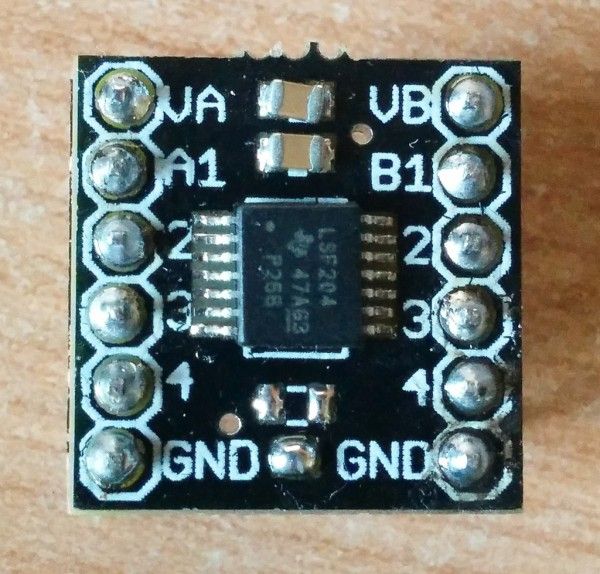I needed a small, fast and reliable multi-voltage level translator (mainly for connecting ESP8266 boards to the Arduino, got tired of resistor networks pretty quickly) so I built a breakout board for TI’s LSF0204(D).
Datasheet and info here.
The LSF0204 is a nice little chip. It can translate up to 4 signals to and from the following values:
1.0 V ↔ 1.8/2.5/3.3/5 V.
1.2 V ↔ 1.8/2.5/3.3/5 V.
1.8 V ↔ 2.5/3.3/5 V.
2.5 V ↔ 3.3/5 V.
3.3 V ↔ 5 V.
It’s very easy to use: connect the reference voltages to VA (1.0-4.5V) and VB (1.8-5.5V), and your signals to A1/2/3/4 or B1/2/3/4. It will translate and output them to the opposite A or B pins.
Features and parts list
- Compatible with both LSF0204 (short jumper) and LSF0204D (solder/short the resistor between the “4” pins).
- Decoupling caps on both voltage lines.
- Optional I2C pull-up resistors (on the back of the board) connected to VA and VB.
- As small as possible! Just 1.6 x 1.6cm!
Parts list:
- U1: LSF0204(D) IC, TSSOP-14 package.
- C1,C2: 0.1uF 0805 package.
- R1-R8: 4.7k-10k ohm, 0805 package (I2C pull-ups, optional).
- R9: 10k ohm, 0805 package. Pull-down resistor to GND, for LSF0204D: the EN pin is active low.
- SJ1: solder jumper to VA, connect for LSF0204 (non-D): the EN pin is active high.
Pictures!
And here’s a couple of picture of some of the boards I received, printed by DirtyPCBs. Awesome service! Also, the black soldermask rocks.
It was also my first try at panelizing and I can say it worked pretty well!
Here a fully assembled one. The chip is pretty small but it was easy to solder with the help of a liquid flux pen and my new Yihua-858D hot air station. Don’t worry, you can solder it with a regular iron too!
For more detail: LSF0204 breakout board: a bidirectional, multi-voltage level converter!

